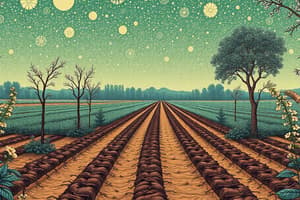Podcast
Questions and Answers
Match the nutrients with their role in soil management:
Match the nutrients with their role in soil management:
Nitrogen = Essential for leaf growth Phosphorus = Promotes root development Potassium = Enhances overall plant health Calcium = Improves soil structure
Match the types of fertilizers with their characteristics:
Match the types of fertilizers with their characteristics:
Organic = Natural and environmentally friendly Synthetic = Chemical, potentially harmful Natural = Derived from plant or animal matter Chemical = Manufactured through industrial processes
Match the processes that impact soil and water:
Match the processes that impact soil and water:
Leaching = Removal of nutrients from soil by water Drainage = Installation of tiles to manage water Compaction = Difficulties for roots to grow Erosion = Loss of topsoil due to wind or water
Match the types of pests with their classifications:
Match the types of pests with their classifications:
Signup and view all the answers
Match the types of pesticides with their target scope:
Match the types of pesticides with their target scope:
Signup and view all the answers
Match the consequences of pesticide use:
Match the consequences of pesticide use:
Signup and view all the answers
Match the outcomes of soil nutrient depletion:
Match the outcomes of soil nutrient depletion:
Signup and view all the answers
Match the terms related to agricultural practices:
Match the terms related to agricultural practices:
Signup and view all the answers
Match the following control methods with their descriptions:
Match the following control methods with their descriptions:
Signup and view all the answers
Match the following aquatic ecosystems with their descriptions:
Match the following aquatic ecosystems with their descriptions:
Signup and view all the answers
Match the following ecosystem services with their examples:
Match the following ecosystem services with their examples:
Signup and view all the answers
Match the following factors with their influence on ecosystems:
Match the following factors with their influence on ecosystems:
Signup and view all the answers
Match the following ecosystem characteristics with their types:
Match the following ecosystem characteristics with their types:
Signup and view all the answers
Match the following risks with their associated control methods:
Match the following risks with their associated control methods:
Signup and view all the answers
Match the following types of services provided by ecosystems:
Match the following types of services provided by ecosystems:
Signup and view all the answers
Match the following aquatic features with their definitions:
Match the following aquatic features with their definitions:
Signup and view all the answers
Match the following concepts with their definitions:
Match the following concepts with their definitions:
Signup and view all the answers
Match the following trophic levels with their corresponding organisms:
Match the following trophic levels with their corresponding organisms:
Signup and view all the answers
Match the following threats to biodiversity with their descriptions:
Match the following threats to biodiversity with their descriptions:
Signup and view all the answers
Match the following terms with their meanings:
Match the following terms with their meanings:
Signup and view all the answers
Match the following forms of succession with their specific characteristics:
Match the following forms of succession with their specific characteristics:
Signup and view all the answers
Match the following actions with their potential impact on ecosystems:
Match the following actions with their potential impact on ecosystems:
Signup and view all the answers
Match the following terms regarding food webs and food chains:
Match the following terms regarding food webs and food chains:
Signup and view all the answers
Match the following types of ecosystems with their characteristics:
Match the following types of ecosystems with their characteristics:
Signup and view all the answers
Flashcards
Equilibrium
Equilibrium
State of an ecosystem with relatively constant conditions over time. Energy flows, but the system remains balanced.
Succession
Succession
Process of recovery after a disturbance. New life takes over and the ecosystem slowly returns to a balanced state.
Primary Succession
Primary Succession
Starts on bare rock or soil where no life existed before. Example: Volcanic eruption
Secondary Succession
Secondary Succession
Signup and view all the flashcards
Biodiversity
Biodiversity
Signup and view all the flashcards
Species Richness
Species Richness
Signup and view all the flashcards
Bioamplification
Bioamplification
Signup and view all the flashcards
Invasive Species
Invasive Species
Signup and view all the flashcards
Limiting Factor
Limiting Factor
Signup and view all the flashcards
Biological Control
Biological Control
Signup and view all the flashcards
Watershed
Watershed
Signup and view all the flashcards
Ecosystem Services
Ecosystem Services
Signup and view all the flashcards
Freshwater Ecosystems
Freshwater Ecosystems
Signup and view all the flashcards
Cultural Services
Cultural Services
Signup and view all the flashcards
Mechanical Control
Mechanical Control
Signup and view all the flashcards
Chemical Control
Chemical Control
Signup and view all the flashcards
Leaching
Leaching
Signup and view all the flashcards
Soil Compaction
Soil Compaction
Signup and view all the flashcards
Pesticides
Pesticides
Signup and view all the flashcards
Broad-spectrum Pesticide
Broad-spectrum Pesticide
Signup and view all the flashcards
Narrow-spectrum Pesticide
Narrow-spectrum Pesticide
Signup and view all the flashcards
Biomagnification
Biomagnification
Signup and view all the flashcards
Bioaccumulation
Bioaccumulation
Signup and view all the flashcards
Algal Bloom
Algal Bloom
Signup and view all the flashcards
Study Notes
Managing the Soil
- Soils are complex and crucial for ecosystems
- Fertilizers (natural or synthetic) add nutrients to the soil
- Organic fertilizers are preferred for local environments
- Synthetic fertilizers can harm soil organisms and groundwater
- Nutrients are removed from the soil through water runoff
- Fertilizers in groundwater can cause algal blooms in aquatic ecosystems
Pests and Poisons
- Pests damage crops and compete with them
- Pests include weeds, insects, and rodents
- Monoculture farming creates favorable pest conditions
- Pesticides kill pests, but some are harmful to the environment
- Pesticides can persist for long periods in soil, water, and air
- Some pests develop resistance to pesticides
Biomagnification
- Pesticides build up in organisms as they consume contaminated food
- Bioaccumulation occurs when toxins concentrate within an organism
- Biomagnification occurs when toxins increase in concentration as they move up the food chain
- Top consumers are most vulnerable to the effects of harmful toxins
Equilibrium and Change
- Most natural ecosystems are in a state of equilibrium
- Equilibrium is characterized by relatively stable conditions over time
- A disturbance can disrupt equilibrium and initiate succession
- Primary succession occurs in newly exposed environments
- Secondary succession occurs when some life still exists
Food Webs and Food Chains
- Food webs show complex feeding relationships between species
- Food chains show simplified linear feeding relationships
- Food webs have greater biodiversity than food chains
Biodiversity
- Biodiversity is the variety of life in an area
- Species richness is the number of species in an area
- Species richness is higher near the equator
- Human activities are threatening biodiversity through habitat destruction, pollution, and climate change
- Species are at risk of extinction
Non-Native Species
- Non-native species can be introduced into an area
- Some non-native species may become invasive
- Chemical, mechanical, and biological methods are employed to control non-native species
Aquatic Ecosystems
- Freshwater ecosystems have low salt concentration
- Marine ecosystems have high salt concentration
- Freshwater ecosystems include rivers and lakes
- Marine ecosystems include oceans
- Wetlands are nutrient-rich freshwater ecosystems
- Watersheds are areas through which water drains into a single river or lake.
On the Next Test - Ecosystem Services
- Natural ecosystems provide services to the biosphere and humans
- Cultural services include recreational, aesthetic, and spiritual experiences in nature
- Ecotourism is an example of a cultural service
- Ecosystem products such as food, timber, and fibers are harvested from nature
- Ecosystems can provide protections from erosion and natural disasters.
Influences on Ecosystems
- Abiotic and biotic factors influence ecosystem stability
- Limiting factors restrict the size of populations within ecosystems
- Tolerance range determines species' survival in environmental conditions
- Organisms' tolerance range may change over time
Energy Flow
- Organisms need energy to stay alive
- Radiant energy from the sun is the primary energy source
- Producers (like plants) convert light energy into chemical energy through photosynthesis
- Photosynthesis uses carbon dioxide, water, and sunlight to produce sugars.
Studying That Suits You
Use AI to generate personalized quizzes and flashcards to suit your learning preferences.
Related Documents
Description
This quiz covers the critical topics of soil management, pest control, and biomagnification. It explores the impact of fertilizers on ecosystems and the challenges posed by pests and pesticides in agriculture. Test your knowledge about sustainable practices and environmental health.




